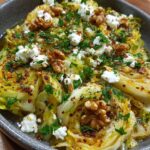Simple Dough Transforms into Golden, Bubbling Flavor Spirals: An Irresistible Savory Pastry
There is something truly magical about watching simple dough transforms into golden, bubbling flavor spirals right before your eyes. This recipe is a testament to the power of a few basic ingredients coming together to create something spectacular. Moreover, the process is incredibly satisfying, offering both a visual and aromatic treat that fills your kitchen with warmth. Ultimately, these savory pastries are perfect for any occasion, from a quick snack to an impressive party appetizer.
The beauty of these golden spirals lies in their versatility. You can fill them with a variety of ingredients, making them a fantastic way to use up leftovers. Additionally, the bubbling cheese and savory filling create a texture that is both crispy and soft. Consequently, every bite delivers a complex experience that is sure to please any palate. Whether you are a seasoned baker or a beginner, this recipe guides you through each step with ease.
Imagine pulling these flaky, golden spirals from the oven, their aroma wafting through your home. The sight of the cheese perfectly melted and slightly browned is irresistible. Furthermore, the spiral shape not only looks beautiful but also ensures every bite contains a perfect ratio of dough to filling. Therefore, this dish is as much a feast for the eyes as it is for the stomach. Get ready to create a memorable culinary experience with minimal effort.
Quick Recipe Highlights
- Flavor Profile: These spirals boast a rich, savory taste with a buttery, flaky crust. The filling typically combines sharp cheese, herbs, and often a protein like ham or spinach, creating a well-balanced and deeply satisfying flavor.
- Texture: Experience a delightful contrast between the crispy, golden exterior and the soft, tender, bubbling interior. The laminated layers of dough provide a light, airy crunch that gives way to the molten center.
- Aroma: As they bake, your kitchen will fill with the comforting scents of toasted butter, yeasted dough, and savory herbs. The aroma is unmistakably inviting and promises a delicious result.
- Visual Appeal: The spiral shape is inherently attractive, showcasing layers of dough and filling. When baked to a perfect golden-brown, they look professionally made and are perfect for sharing on social media.
- Skill Level Needed: This recipe is beginner-friendly. While the result looks impressive, the technique involves simple rolling and folding. Basically, anyone who can use a rolling pin can achieve great results.
- Special Equipment: You need only a rolling pin, a baking sheet, and parchment paper. A sharp knife or pizza cutter helps for clean cuts, but otherwise, no special tools are required.
Recipe Overview
- Difficulty Level: We rate this recipe as easy because it uses a straightforward dough or a quality store-bought alternative. The shaping technique is simple to master, and the baking time is forgiving. Even if your spirals aren’t perfectly uniform, they will still taste fantastic.
- Category: This dish falls squarely into the appetizer, snack, or party food category. It can also serve as a light lunch or dinner when paired with a fresh salad. Essentially, it’s a versatile pastry for any time of day.
- Cuisine: While spiral pastries appear in many cultures, this recipe has a general European inspiration, reminiscent of Italian stromboli or Eastern European savory rolls. The focus is on accessible, universal flavors that everyone enjoys.
- Cost: This is an economical recipe, especially if you make your own dough. Using store-bought dough increases the cost slightly but saves significant time. The fillings are flexible, allowing you to control the budget based on your choices.
- Season: These golden spirals are perfect year-round. They are comforting in the colder months and work well for picnics and barbecues in the summer. Consequently, they are a reliable go-to recipe for any season.
- Occasion: Ideal for game day, potlucks, holiday parties, or a fun family cooking project. They are also great for brunch or as a packed lunch treat. Basically, they suit any gathering where delicious, handheld food is welcome.
Why You’ll Love This Recipe
You will adore this recipe because it delivers maximum flavor with minimal effort. The process of watching simple dough transforms is incredibly rewarding. Furthermore, the versatility of the fillings means you can customize it to your exact preferences. Whether you crave a classic ham and cheese combination or a vegetarian option with spinach and feta, the result is always delicious. The aroma that fills your home as they bake is simply unbeatable.
Another reason to love this recipe is its convenience. You can prepare these spirals ahead of time and bake them when needed. This makes them perfect for busy weeknights or unexpected guests. Additionally, they reheat beautifully, so you can enjoy them over several days. The fact that they are handheld also means less cleanup, which is always a win.
From a nutritional standpoint, you have control over the ingredients. You can pack them with vegetables, use lean proteins, and choose whole-wheat dough for added fiber. This allows you to create a treat that is both indulgent and somewhat wholesome. Compared to store-bought pastries, your homemade version will be free from preservatives and unnecessary additives.
The social value of this dish is high. These golden, bubbling spirals are meant for sharing. They are a guaranteed conversation starter at any party. Moreover, involving kids or friends in the rolling and filling process makes for a fun group activity. The sense of accomplishment when you pull the tray out of the oven is a feeling everyone can share.
Finally, this recipe is incredibly cost-effective. A basic dough is inexpensive to make, and the fillings can be adapted based on what you have on hand. This is a fantastic way to reduce food waste by using leftover meats, cheeses, and vegetables. You get an impressive, delicious result without spending a lot of money, which is the best kind of cooking.
Historical Background and Cultural Significance
Spiral pastries have a rich history across many cultures. The concept of rolling dough with a filling is an ancient one, born from the practical need to create portable, preserved meals. For instance, many cultures have their own version, from Eastern European kalachi to Italian stromboli. The spiral shape is not just decorative; it often symbolizes eternity or continuity in various traditions.
In Europe, bakers perfected the art of laminated doughs, leading to flaky, buttery pastries like the croissant. While our recipe is simpler, it draws inspiration from this tradition of creating layers. The idea was to maximize the surface area for browning, creating a texture that is both crisp and tender. This technique traveled across continents, adapting to local ingredients and tastes.
The evolution of this specific recipe is a modern one, reflecting our current love for fusion cuisine and easy, impressive baking. It takes the principles of classic pastry-making and simplifies them for the home cook. The use of store-bought dough is a relatively recent convenience that has made these delicacies accessible to everyone. Today, these spirals are a staple of potlucks and party platters.
Regional variations are endless. In the American South, you might find a version with pimento cheese and jalapeños. In the Mediterranean, fillings like olives, sun-dried tomatoes, and feta cheese are popular. This adaptability is a key part of the recipe’s enduring appeal. It serves as a blank canvas for culinary creativity, allowing each baker to leave their personal touch.
Ingredient Deep Dive
Let’s start with the dough. Whether you use a homemade yeasted dough or a quality store-bought puff pastry, this is the foundation. A good dough should be elastic and easy to roll out. If you are using puff pastry, the layers of butter are what create that incredible, flaky rise. For a softer result, a pizza dough works wonderfully. The choice of dough directly influences the final texture of your golden spirals.
Cheese is the star of the filling, providing the signature bubbling effect. Mozzarella is a classic choice for its excellent meltability and mild flavor. However, you can mix it with sharper cheeses like cheddar or Gruyère for more depth. Parmesan adds a salty, umami kick. Importantly, always grate your own cheese from a block, as pre-shredded cheese contains anti-caking agents that can hinder melting.
The savory component is next. Diced ham, cooked sausage, bacon, or even shredded chicken are all excellent options. For a vegetarian version, sautéed mushrooms, spinach, or roasted vegetables work beautifully. The key is to ensure any fillings are not too wet, as excess moisture can make the dough soggy. Always pat vegetables dry after washing or cooking them.
Flavor enhancers like herbs and spices are crucial. Fresh parsley, chives, or basil add brightness. Dried oregano, garlic powder, or onion powder provide a more robust base note. A pinch of red pepper flakes can add a welcome touch of heat. Don’t forget seasoning; a simple sprinkle of salt and black pepper on the dough before adding the filling makes a world of difference.
Finally, the egg wash is a small but mighty ingredient. Brushing the rolled spirals with a beaten egg mixed with a little water or milk gives them that professional, deep golden brown color and a slight shine. It acts as a glue for any additional toppings like sesame seeds or everything bagel seasoning. This final step ensures your pastry looks as good as it tastes.
Common Mistakes to Avoid
- Using Wet Fillings: Excess moisture is the enemy of a crisp pastry. If you use vegetables like spinach or mushrooms, sauté them first to release their water and then pat them dry thoroughly. Otherwise, you risk a soggy bottom.
- Overfilling the Dough: It’s tempting to pack in as much filling as possible, but this can cause the spirals to burst open during baking. Leave a small border around the edges to allow for sealing and expansion.
- Not Sealing the Edge Properly: After rolling the dough into a log, pinch the final seam firmly to seal it. If it’s not sealed, the log can unroll in the oven, and the filling will spill out.
- Using Cold Dough: If your dough is too cold from the refrigerator, it will be stiff and difficult to roll, and it may crack. Let it sit at room temperature for 5-10 minutes until it’s pliable but still cool.
- Skipping the Egg Wash: The egg wash is not just for color; it also helps create a slightly crispier exterior. Skipping it will result in a paler, less appealing pastry.
- Cutting with a Dull Knife: A dull knife will drag and squish the spiral log instead of making a clean cut. Use a sharp serrated knife or a piece of dental floss for perfect, uncompressed slices.
- Baking on a Cold Pan: For an extra-crispy bottom, preheat your baking sheet in the oven while it preheats. Then, carefully place the parchment-lined spirals onto the hot pan to start cooking the bottom immediately.
- Not Letting Them Cool Slightly: The filling will be molten lava hot straight from the oven. Let the spirals rest on the baking sheet for at least 5 minutes. This allows the cheese to set slightly, making them easier to eat.
Essential Techniques
Rolling the Dough: Achieving an even rectangle is the first crucial technique. Start from the center and roll outwards, turning the dough occasionally to maintain the shape. The goal is a uniform thickness, about 1/4-inch thick, so the pastry cooks evenly. If the dough springs back, let it rest for a few minutes to relax the gluten. This prevents it from shrinking during baking.
Even Filling Distribution: Sprinkle your fillings evenly, leaving a one-inch border on all sides. This ensures every slice has a balanced amount of flavor and prevents the filling from leaking out the ends. Think of it like topping a pizza; an even layer is better than big clumps in one area and nothing in another.
Tight Rolling: This is the step where simple dough transforms into its signature spiral shape. Start from the long side and roll the dough tightly over the filling, like a jelly roll. Use your fingers to tuck the filling in as you go. A tight roll creates distinct layers and holds the spiral form during baking.
Chilling Before Baking: After you’ve cut the log into spirals, place them on the baking sheet and pop them in the refrigerator for 10-15 minutes. This chills the butter in the dough, which leads to a better rise and flakier layers in the oven. It also helps the spirals hold their shape.
Pro Tips for Perfect Golden, Bubbling Flavor Spirals
- For extra flavor, brush the dough with a very thin layer of Dijon mustard or pesto before adding the other fillings. This adds a hidden layer of complexity that people will love.
- If you have time, let the assembled spirals proof for 20-30 minutes in a warm place before baking. This will make the dough even lighter and airier.
- Add a sprinkle of grated Parmesan cheese and Italian seasoning on top of the egg wash for an extra flavor boost and a beautiful, textured crust.
- For a glossy, professional finish, you can brush the baked spirals with a little melted butter as soon as they come out of the oven.
- If the ends of your spiral log seem to have less filling, you can tuck a little extra cheese into them before the final seal to ensure every bite is perfect.
- Use a pizza stone or steel if you have one. Preheating it with the oven will give you an incredibly crisp and evenly baked bottom crust.
- For easy cleanup and to prevent sticking, always use parchment paper. Silicone baking mats also work very well.
Variations and Adaptations
The possibilities for variations are nearly limitless. For a Mediterranean twist, use a combination of feta cheese, chopped Kalamata olives, sun-dried tomatoes, and fresh oregano. Alternatively, create a pizza-inspired version with pepperoni, mozzarella, and a brush of pizza sauce on the dough. For a breakfast spiral, fill with scrambled eggs, cooked bacon, and cheddar cheese. The basic method remains the same, allowing your creativity to run wild.
Consider seasonal adaptations. In the spring, use asparagus and goat cheese. During summer, try a caprese version with fresh basil, mozzarella, and diced tomatoes (ensure they are de-seeded to avoid sogginess). In the fall, caramelized onions, sautéed mushrooms, and Gruyère cheese are a wonderful combination. This keeps the recipe exciting and relevant throughout the year.
For dietary modifications, the recipe is highly adaptable. Use gluten-free puff pastry for a celiac-friendly option. For a dairy-free version, choose vegan cheese and a plant-based butter dough. To increase protein, add more lean meat or even incorporate lentils. The structure of the recipe is robust enough to handle these changes while still producing delicious results.
Serving and Presentation Guide
Presentation is key to making these spirals look as good as they taste. Arrange them on a wooden board or a beautiful platter, perhaps with a small bowl of marinara sauce or garlic aioli for dipping. Garnish with fresh, finely chopped herbs like parsley or chives to add a pop of color. The contrast between the green herbs and the golden-brown pastry is visually stunning.
Think about your serving occasion. For a party, these are perfect finger food. For a more formal appetizer, you could serve one spiral per person on a small plate with a side salad. If serving as a main course, two to three spirals per person is a good estimate, accompanied by a soup or a larger salad. Always consider the overall balance of the meal.
Storage and Shelf Life
These pastries are best served warm from the oven. However, you can store leftover baked spirals in an airtight container in the refrigerator for up to 3 days. To reheat, place them on a baking sheet in a 350°F (175°C) oven for about 10 minutes, or until warm and crisp. Avoid microwaving, as it will make the pastry soft and chewy.
You can also freeze the baked spirals for up to 2 months. Let them cool completely, then wrap them individually in plastic wrap and place them in a freezer bag. Reheat from frozen in the oven. Alternatively, you can freeze the unbaked spirals on a baking sheet until solid, then transfer to a bag. Bake directly from frozen, adding a few extra minutes to the cooking time.
Make Ahead Strategies
This recipe is excellent for making ahead. You can assemble the entire log, wrap it tightly in plastic wrap, and refrigerate it for up to 24 hours before slicing and baking. This is perfect for holiday mornings or parties. You can also slice the spirals and freeze them unbaked on a parchment-lined sheet. Once frozen, transfer them to a container. Bake from frozen, adding 5-7 minutes to the bake time.
Another great strategy is to prepare the fillings a day in advance. Cook and chop any meats, grate the cheese, and sauté the vegetables. Store each component in separate containers in the fridge. Then, when you’re ready to bake, simply roll out the dough, assemble, and bake. This streamlines the process and makes it feel much quicker.
Frequently Asked Questions
Can I use pizza dough for this recipe?
Absolutely. Pizza dough works very well and will give you a softer, bread-like spiral. Puff pastry will result in a flakier, more buttery texture. Both are excellent choices depending on your preference.
My cheese leaked out everywhere during baking. What happened?
This usually means the spirals were overfilled or not sealed tightly enough. Next time, use a bit less cheese and make sure to pinch the final seam of the dough log very firmly to create a tight seal.
Can I make these completely ahead and just reheat them?
Yes, but for the best texture, I recommend reheating them in an oven or toaster oven to restore the crispness. They will still be tasty reheated, but the pastry will be at its peak right after baking.
Why did my spirals not brown evenly?
Uneven browning can be caused by an oven with hot spots. Try rotating the baking sheet halfway through the cooking time. Also, ensure you applied the egg wash evenly, as this promotes browning.
Is it necessary to use an egg wash?
It’s highly recommended. The egg wash gives the pastry a beautiful golden color and a slight shine. If you can’t use egg, you can brush with milk or heavy cream, but the color won’t be as deep.
How do I prevent the bottom from getting soggy?
Ensure your fillings are not wet. Also, baking on a preheated baking sheet or a pizza stone can help cook the bottom quickly and prevent sogginess. Using parchment paper also helps.
Can I use phyllo dough instead?
Phyllo dough is very delicate and requires a different handling technique with layers of butter. It’s not ideal for this specific rolling and slicing method. Stick with puff pastry or a yeasted dough for best results.
What’s the best way to cut the log without squishing it?
Use a very sharp serrated knife and a gentle sawing motion. Alternatively, unflavored dental floss works amazingly well. Slide the floss under the log, cross the ends over the top, and pull to make a clean cut.
I’m Billy, a classically trained culinary school graduate from The Culinary Institute of America with over 12 years in the restaurant industry and over 19 years of cooking experience.







